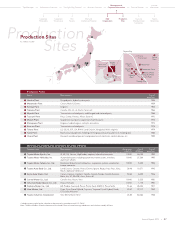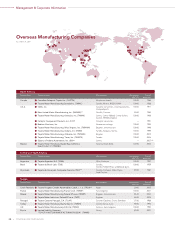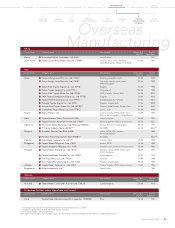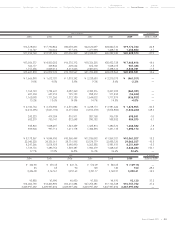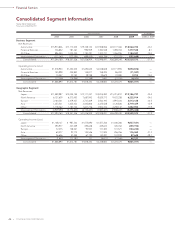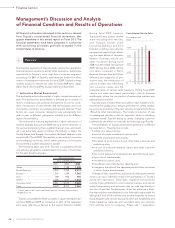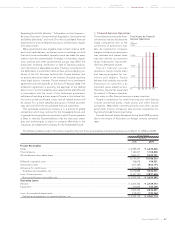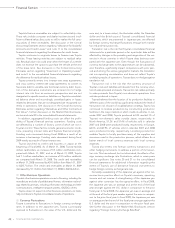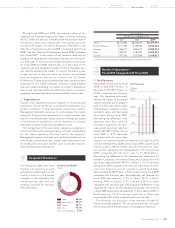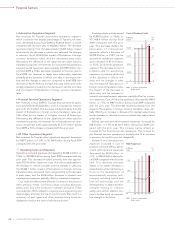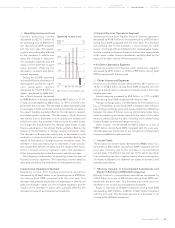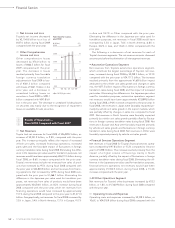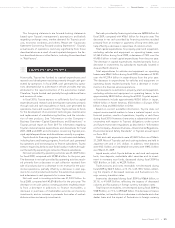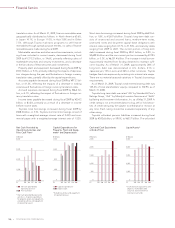Toyota 2009 Annual Report Download - page 49
Download and view the complete annual report
Please find page 49 of the 2009 Toyota annual report below. You can navigate through the pages in the report by either clicking on the pages listed below, or by using the keyword search tool below to find specific information within the annual report.
The Right Way Forward Business OverviewPerformance Overview Financial Section
Investor
Information
Management &
Corporate Information
Top Messages
Annual Report 2009 47
Regarding End-of-Life Vehicles,” “Information on the Company—
Business Overview—Governmental Regulation, Environmental
and Safety Standards” and note 23 to the consolidated financial
statements for a more detailed discussion of these laws, regula-
tions and policies.
Many governments also regulate local content, impose tariffs
and other trade barriers, and enact price or exchange controls
that can limit an automaker’s operations and can make the repa-
triation of profits unpredictable. Changes in these laws, regula-
tions, policies and other governmental actions may affect the
production, licensing, distribution or sale of Toyota’s products,
cost of products or applicable tax rates. Toyota is currently one of
the defendants in purported national class actions alleging vio-
lations of the U.S. Sherman Antitrust Act. Toyota believes that
its actions have been lawful. In the interest of quickly resolving
these legal actions, however, Toyota entered into a settlement
agreement with the plaintiffs at the end of February 2006. The
settlement agreement is pending the approval of the federal
district court, and immediately upon approval the plaintiffs will,
in accordance with the terms of the settlement agreement,
withdraw all pending actions against Toyota in the federal dis-
trict court as well as all state courts and all related actions will
be closed. For a more detailed description of these proceed-
ings, see note 23 to the consolidated financial statements.
The worldwide automotive industry is in a period of global
competition which may continue for the foreseeable future, and
in general the competitive environment in which Toyota operates
is likely to intensify. Toyota believes it has the resources, strate-
gies and technologies in place to compete effectively in the
industry as an independent company for the foreseeable future.
Financial Services Operations
The worldwide automobile finan-
cial services industry has become
highly competitive due to the
contraction of automotive mar-
kets. As competition increases,
margins on financing transactions
may decrease and market share
may also decline as customers
obtain financing for Toyota vehi-
cles from alternative sources.
Toyota’s financial services
operations mainly include loans
and leasing programs for cus-
tomers and dealers. Toyota
believes that its ability to provide
financing to its customers is an
important value added service.
Therefore, Toyota has expanded
its network of finance subsidiar-
ies in order to offer financial services in many countries.
Toyota’s competitors for retail financing and retail leasing
include commercial banks, credit unions and other finance
companies. Meanwhile, commercial banks and other captive
automobile finance companies also provide competition for
Toyota’s wholesale financing activities.
Toyota’s financial assets decreased during fiscal 2009 primarily
due to the impact of fluctuations in foreign currency translation
rates.
Total Assets by Financial
Services Operations
0
4,000
8,000
12,000
16,000
(¥ Billion)
’08’07 ’09’06’05FY
The following table provides information regarding Toyota’s finance receivables and operating leases as of March 31, 2008 and 2009.
Yen in millions
March 31,
2008 2009
Finance Receivables
Retail .............................................................................................................................................................................. ¥ 6,959,479 ¥ 6,655,404
Finance leases ............................................................................................................................................................... 1,160,401 1,108,408
Wholesale and other dealer loans .............................................................................................................................. 2,604,411 2,322,721
10,724,291 10,086,533
Deferred origination costs ........................................................................................................................................... 106,678 104,521
Unearned income ......................................................................................................................................................... (437,365) (405,171)
Allowance for credit losses .......................................................................................................................................... (117,706) (238,932)
Total finance receivables, net .................................................................................................................................. 10,275,898 9,546,951
Less—Current portion .................................................................................................................................................. (4,301,142) (3,891,406)
Noncurrent finance receivables, net ....................................................................................................................... ¥ 5,974,756 ¥ 5,655,545
Operating Leases
Vehicles .......................................................................................................................................................................... ¥ 2,814,706 ¥ 2,729,713
Equipment ..................................................................................................................................................................... 107,619 107,168
2,922,325 2,836,881
Less—Accumulated depreciation ............................................................................................................................... (718,207) (795,767)
Vehicles and equipment on operating leases, net ................................................................................................ ¥ 2,204,118 ¥ 2,041,114


